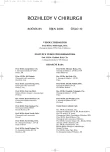Morgagni Diaphragmatic Hernia in Childhood
Morgagniho brániční kýly v dětském věku
Cílem práce bylo retrospektivní zhodnocení klinických a anatomických rysů u dětí s Morgagniho vrozenou brániční kýlou.V souboru bylo 5 chlapců a 3 dívky, věk v době diagnózy se pohyboval v rozmezí od 5 měsíců do 13 let. Brániční Morgagniho kýla byla diagnostikována u 8 dětí při neakutních projevech. Retrosternální defekt v bránici byl u 7 dětí na levé straně a u 1 chlapce oboustranně. Kýlní vak byl nalezen u 6 dětí. U 3 dětí byla v kýlním vaku játra, omentum u 2 dětí, transversum a tenké kličky u 2 a transversum s omentem u jednoho dítěte. Defekt v bránici byl u všech dětí uzavřen primární plastikou. Všechny děti se zahojily bez komplikací. Na vrozenou Morgagniho brániční kýlu je nutné myslet diferenciálně diagnosticky u dětí s neobvyklými respiračními nebo gastrointestinálními symptomy a abnormálním rentgenovým nálezem při vyšetření hrudníku. Uskřinutí vrozené Morgagniho brániční kýly je vzácné, v našem souboru jsme ho nezaznamenali.
Klíčová slova:
Morgagniho brániční kýla – děti – diagnostika
Authors:
M. Vyhnánek; M. Rygl; J. Šnajdauf; R. Škába; M. Kynčl *
Authors‘ workplace:
Klinika dětské chirurgie 2. LF UK Praha a FN Motol, subkatedra dětské chirurgie IPVZ, Praha
přednosta: prof. MUDr. J. Šnajdauf, DrSc.
; Klinika zobrazovacích metod 2. LF UK Praha a FN Motol, přednosta: prof. MUDr. J. Neuwirth, CSc.
*
Published in:
Rozhl. Chir., 2006, roč. 85, č. 10, s. 494-497.
Category:
Monothematic special - Original
Overview
The aim of this work was to retrospectively assess clinical and anatomical features of children with Morgagni congenital diaphragmatic hernias. The study group included 5 boys and 3 girls, aged between 5 months and13 years, at the time of the diagnosis. Morgagni diaphragmatic hernia was diagnosed with non-acute symptoms in 8 children. A retrosternal defect of the diaphragm was left-sided in 7 subjects and bilateral in 1 boy. A hernial sac was found in 6 children. In 3 subjects, the hernial sac contained the liver, in 2 subjects the omentum, in 2 subjects the transverse colon and small intestinal loops and in one child it contained the transverse colon with the omentum. In all cases, the diaphragmatic defect was closed using primary plasty. All subjects healed without complications. A differential diagnosis of congenital Morgagni hernia must be considered in children with unusual respiratory and gastrointestinal symptoms with abnormal x-ray findings on chest examination. A stricture of the congenital Morgagni diaphragmatic hernia is rare, and was not recorded in our group.
Key words:
Morgagni diaphragmatic hernia – children – diagnostics
Labels
Surgery Orthopaedics Trauma surgeryArticle was published in
Perspectives in Surgery

2006 Issue 10
- Metamizole vs. Tramadol in Postoperative Analgesia
- Metamizole at a Glance and in Practice – Effective Non-Opioid Analgesic for All Ages
- Current Insights into the Antispasmodic and Analgesic Effects of Metamizole on the Gastrointestinal Tract
Most read in this issue
- Arthroscopic Management of Traumatic Luxation of the Patella
- Complications of the Longo Procedure – Rectal Occlusion
- Morgagni Diaphragmatic Hernia in Childhood
- Rates and Histological Characteristics of Rectal Polyps in Childhood
